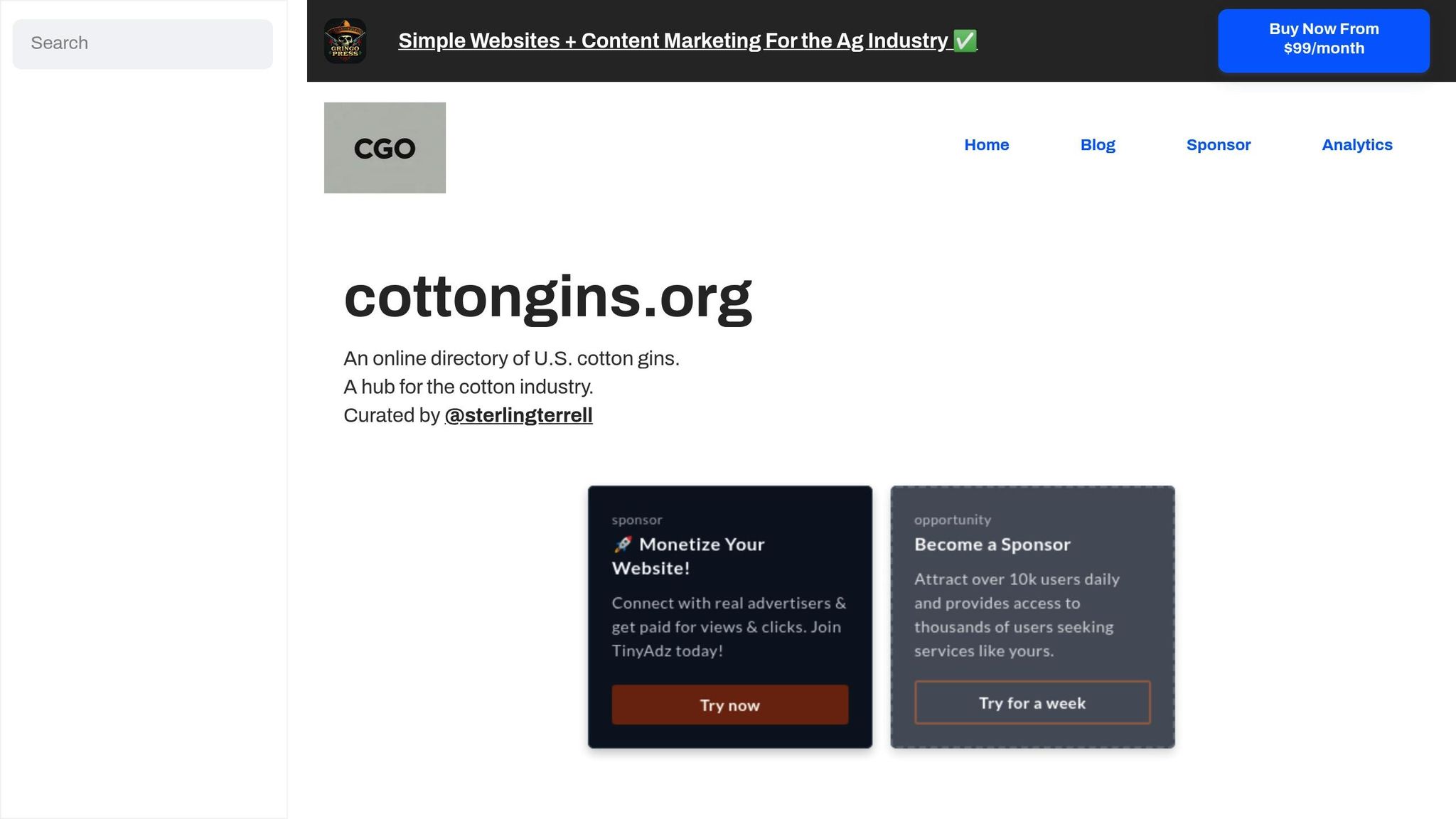The U.S. cotton market faces increasing price swings, creating challenges for farmers, gin operators, and the entire supply chain. Here's a quick summary of the main causes and solutions:
Causes of Price Volatility:
- Weather Disruptions: Droughts, hurricanes, and unpredictable rainfall lower yields and tighten supply.
- Global Supply and Demand: Shifts in production or consumption impact prices.
- Futures Market Speculation: Trading activity can amplify short-term price changes.
- Trade Policies: Tariffs and farming support programs influence planting decisions and exports.
Solutions for Stakeholders:
- Financial Tools: Use futures, options, forward, and basis contracts to stabilize prices.
- Flexible Contracts: Short-term agreements reduce long-term risks.
- Supply Chain Partnerships: Collaborate with farmers, gins, and buyers for better risk management.
- Reliable Resources: Platforms like cottongins.org help locate gins, streamline operations, and stay updated.
Bottom Line: To navigate market uncertainty, stakeholders need strong planning, financial safeguards, and reliable partnerships. Tools like cottongins.org provide critical support for adapting to changing conditions.
Forecasting Cotton future prices with AI, by Emre Balduk ...
Main Causes of Cotton Price Swings
Cotton prices in the U.S. can fluctuate widely due to several key influences. From changes in supply and demand to weather and trade policies, these factors combine to create a dynamic market.
Supply and Demand Shifts
Global production and consumption patterns play a major role in shaping U.S. cotton prices. When output changes in leading cotton-producing countries, it often sends shockwaves through the market. Similarly, shifts in consumer demand can lead to noticeable price fluctuations.
Weather's Role in Production
Extreme weather events like droughts, hurricanes, and unpredictable rainfall can disrupt cotton farming. These conditions may delay planting or lower yields, often leading to higher market prices as supply tightens.
Impact of Futures Market Activity
Trading in cotton futures markets can amplify price swings. Speculative activity, in particular, can cause short-term price spikes or drops, making the market more unpredictable beyond the usual supply-and-demand factors.
Influence of Policies and Trade Agreements
Government actions, such as tariff changes or updates to domestic farming support programs, can significantly affect cotton prices. These policies may impact export demand or influence farmers' planting decisions, adding another layer of complexity to price movements.
These interconnected factors - ranging from global demand shifts to weather and policy changes - create a challenging environment for predicting and understanding cotton price trends.
Cotton Gin Industry Problems
Cotton gin operators in the U.S. are grappling with financial and logistical hurdles caused by unpredictable cotton market prices. These challenges directly affect their ability to remain competitive and grow.
Price Changes and Planning
Frequent shifts in cotton prices create tough conditions for gin operators. They’re often forced to revise fee structures, renegotiate contracts, and delay investing in equipment. To stay operational, cotton gins usually need to:
- Hire seasonal workers ahead of time
- Schedule maintenance during slower periods
- Plan for large capital purchases
- Work out service agreements with farmers
These pricing issues ripple through every part of the supply chain, adding complexity to the process.
Supply Chain Effects
Price volatility doesn’t just affect individual gins - it disrupts the entire supply chain. When prices swing, the movement of cotton from farms to gins to textile manufacturers can be thrown off track. Here’s how it impacts different stages:
| Supply Chain Stage | Impact |
|---|---|
| Farmers | Changes in harvest timing and planting plans |
| Gin Operators | Inconsistent processing volumes and staffing challenges |
| Storage Facilities | Overcrowded storage and higher holding costs |
| Transportation | Delays in schedules and rising transportation expenses |
Stock and Cash Management
Managing inventory and cash flow becomes a balancing act in unpredictable market conditions. Operators must juggle working capital needs with storage limits and processing schedules. Rapid price changes often strain cash flow, forcing difficult decisions about maintenance, staffing, operating hours, and storage. To handle these challenges, many operators rely on flexible schedules and maintain strong cash reserves to weather the ups and downs.
sbb-itb-0e617ca
Market Protection Methods
Use strategies like financial safeguards, shorter contracts, and strong supply chain partnerships to navigate market uncertainties.
Price Protection Tools
Financial tools can help stabilize cotton prices across the supply chain:
- Futures Contracts: Secure prices in advance.
- Options Trading: Set price limits with flexibility.
- Forward Contracts: Lock in future pricing.
- Basis Contracts: Manage regional price risks.
These tools help reduce the impact of sudden price changes and provide a foundation for more predictable contracts.
Contract Adjustments
Many businesses are shifting to shorter contracts, such as quarterly or monthly agreements. This approach allows:
- Frequent price updates to match market trends
- Reduced long-term financial risks
- Flexible commitments on order volumes
In addition to adjusting contracts, building strong relationships within the supply chain can further reduce risks.
Supply Chain Partnerships
Fostering reliable partnerships within the supply chain can help businesses remain steady during market fluctuations. Here’s how:
- Transparent Information Sharing: Open communication about production schedules and market trends allows partners to make timely adjustments.
- Joint Risk Management: Sharing market insights and coordinating strategies ensures better risk handling for everyone involved.
- Collaborative Planning: Regular discussions between farmers, gin operators, and buyers can help identify potential issues early and address them before they escalate.
Strong partnerships create a safety net, helping all parties adapt to changing market conditions effectively.
Using cottongins.org

Navigating the cotton industry's ups and downs requires reliable tools and resources. cottongins.org serves as a go-to platform for stakeholders, helping them tackle market challenges effectively.
Finding U.S. Cotton Gins
The directory on cottongins.org lists cotton gins across key cotton-producing states like Alabama, Arkansas, Arizona, California, Florida, Georgia, Louisiana, and Mississippi. This resource ensures businesses can act quickly and efficiently in fluctuating markets. Here's how it helps:
- Streamline Operations: Locate nearby gins to cut transportation costs when prices shift.
- Optimize Supply Chains: Identify alternative gins if primary ones are at capacity.
- Reduce Response Time: Access contact details instantly for quick decision-making.
Additionally, the platform allows new gin facilities to submit their information, keeping the directory up-to-date and relevant.
Marketing Options
For cotton gin operators, staying visible is critical, especially during uncertain market conditions. cottongins.org offers sponsorship opportunities tailored to boost visibility:
| Sponsorship Level | Monthly Cost | Benefits |
|---|---|---|
| Featured Sponsor | $400 | Premium placement, two sponsored posts yearly |
| Official Sponsor | $200 | Footer placement, one sponsored post yearly |
| Sponsored Post | $200 per post | Top visibility for 24 hours, shared on social media |
These options help businesses maintain a strong presence, even in challenging times.
Market Updates
To support informed decision-making, cottongins.org provides essential updates and insights:
- Email Updates and Market Trends: Regular updates with expert insights.
- Directory Updates: Real-time information on gin operations and availability.
Conclusion
The U.S. cotton industry faces challenges from market volatility, making planning and management more complex across the supply chain. To navigate these uncertainties, stakeholders need effective risk management tools. Resources like cottongins.org provide easy access to cotton gin facilities in major states such as Alabama, Georgia, and Mississippi, helping businesses streamline operations during uncertain times.
A well-rounded approach can help:
- Strategic Planning: Use directories and market data to guide decisions.
- Supply Chain Flexibility: Build relationships with multiple gin facilities to stay agile.
- Market Awareness: Keep up with industry trends and updates to make informed choices.
Combining these elements creates a stronger, more adaptable strategy. Cotton gin operators can benefit by staying visible and resourceful. Tools like cottongins.org, with its sponsorship and directory options, help businesses maintain efficiency and build partnerships, even during challenging market conditions.
FAQs
How does weather affect cotton market prices, and what steps can farmers take to reduce its impact?
Weather plays a significant role in the cotton market, as conditions like droughts, heavy rainfall, or unexpected frosts can disrupt crop yields and quality. These disruptions often lead to fluctuations in supply, which in turn affects market prices. For example, a severe drought can reduce cotton production, driving prices higher due to limited availability.
To mitigate these effects, farmers can adopt strategies such as planting drought-resistant cotton varieties, implementing advanced irrigation systems, and diversifying their crops to reduce dependency on cotton alone. Additionally, staying informed about weather patterns and market trends can help farmers plan better and make timely decisions to protect their livelihoods.
How does speculation in the futures market impact cotton prices, and what steps can stakeholders take to manage these fluctuations?
Speculation in the cotton futures market can significantly influence price volatility. Traders often base their decisions on market trends, weather forecasts, and global demand, which can lead to rapid price swings. While speculation can provide liquidity, it also introduces uncertainty for stakeholders like farmers, manufacturers, and buyers.
To manage these fluctuations, stakeholders can use strategies such as hedging through futures contracts, diversifying their operations, and closely monitoring market trends. Building strong relationships with local cotton gin operators, such as those listed on cottongins.org, can also provide valuable insights and support for navigating market challenges.
How can cotton gin operators use resources like cottongins.org to navigate market volatility and improve their operations?
Cotton gin operators can leverage resources like cottongins.org to better navigate market uncertainties by connecting with a comprehensive directory of U.S. cotton gins. This tool allows operators to identify potential partnerships, explore regional opportunities, and expand their network within the cotton industry.
While the site primarily serves as a directory, it also provides opportunities for sponsorships and the submission of new cotton gin entries, which can help operators increase visibility and stay connected during volatile market periods. Utilizing such resources ensures that operators remain informed and well-positioned to adapt to changing market conditions.


